Top News
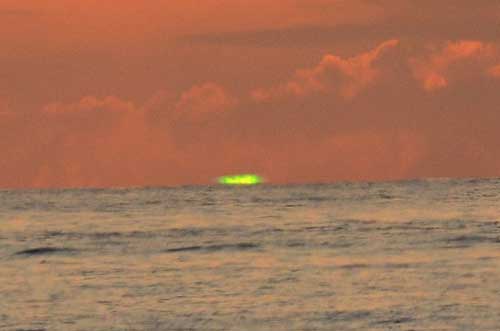
November 26, 2014 Ryukyu Shimpo
On the evening of November 25, a green flash phenomenon, in which the sun shines green at sunset, was confirmed to have been sighted in Okinawa. Akihiro Noda, a 37-year-old company employee, managed to take a picture of the moment when the sun flashed green. He took the photo on Senagajima Island.
According to the director of Ishigaki Island Observatory Takeshi Miyaji, the green flash is an atmospheric phenomenon where the sun turns green at sunset because the green light of the seven colours of the solar spectrum reaches the surface of the earth. It is only visible if the air is clean and there are no clouds over the sea.
Miyaji said, “The green flash is relatively easily to sight in Okinawa where the sea spreads toward the west, compared to other prefectures. However, the green flash is a fairly rare phenomenon.”
Noda saw the green flash by chance at Senagajima 12 years ago. Since then, he has wanted to see it again, and he has visited the island many times. “I did not expect to be able to see it again. I am very happy,” Noda said with excitement.
(English translation by T&CT)
Go to Japanese
November 27, 2014 Ryukyu Shimpo
The U.S. forces in Japan will revise its ‘liberty policy’, the code of conduct for the U.S. service members and civilian employees in Okinawa. This will allow them to stay out and drink off base during off-duty hours from December 9. Responding to requests from restaurant business owners in Okinawa City and other towns near the bases, the military authority made the decision to relax its policy. U.S. service members will be allowed to drink off base for the first time in two years, but are still banned from drinking in public off base between midnight and 5 a.m. A limit on the amount of drinking will also be eased. The U.S. forces, including marines, navy, air force and army in Okinawa, reported this measure to the Okinawa Prefectural Government on November 26.
The updated rules require service members who are E5 (sergeant rank or equivalent) and below, and those who are on temporary duty in Okinawa to be accompanied by superiors.
A spokesman for the US forces in Japan Lt. Col. Kenneth Hoffman said the forces have set up a new standard rather than abolishing the ban. He said any delinquency and illegal acts by U.S. military members and civilian employees should not be permitted.
The U.S. Forces in Japan has implemented measures such as restricting off-base movements during a nighttime curfew for the service members, including those in Okinawa, after two U.S. soldiers assaulted an Okinawan woman in October 2012. In February 2013, the service members, who were high-ranking, were allowed to be outside at nighttime but banned from drinking. From May 20, 2013, the military allowed the service members to drink about two canned beers at off-base restaurants between 6 p.m. and 10 p.m.
In 2013, the food and beverage industry associations in Kin Town and Okinawa City requested the U.S. forces to ease the ban. They have expressed to the U.S forces that as a result of restaurants being shut-down or suspended, they are in a difficult economic situation.
Between November 2012, when the U.S. force in Japan started the curfew and off-base drinking ban, and August 2013, 15 crimes involving drinking were investigated, and 13 service members were arrested. The figure had decreased by 18 and 17 respectively from the same period the previous year. There were 8 cases of accidents causing injury or death involving drinking by service members. The figure is the same as the same period the previous year. However, the number of drink-driving cases involving service members was 25 cases, 20 less than the period before the curfew started.
(English translation by T&CT)
Go to Japanese

November 19, 2014 Ryukyu Shimpo
In December, two Asian elephants from Tohoku Safari Park in Fukushima are coming to Okinawa Zoo and Museum to spend the winter. On November 18, Okinawa City Mayor Sachio Kuwae and the president of Tohoku Safari Park Nobushige Kumakubo signed an agreement on the care of the two elephants, at Okinawa City Office on November 18.
From October 2012, Tohoku Safari Park has cared for two elephants, Tonsai and Boonthong as part of a project called “Japan-Lao Goodwill Elephant”. The temperature in Fukushima during winter gets as low as minus 10 degree Celsius. These animals need to have their room kept warm at 15 degrees celsius.
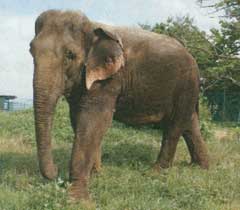
Boonthong
Moving the two elephants to Okinawa during winter also provides a chance to promote Fukushima to Okinawa, as well as saving on the heating bill. Kumakubo said, “I want local people and earthquake disaster refugees living in Okinawa from Fukushima to feel the kindness and cuteness of the elephants and enjoy touching them.”
Three Lao mahouts will visit Okinawa with the two elephants. Children can enjoy riding the elephants at Okinawa Zoo and Museum.
(English translation by T&CT, Hitomi Shinzato)
Go to Japanese
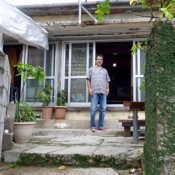
November 24, 2014 Ryukyu Shimpo
Located in the Goya district of Okinawa City, guest house Goya is a 40-year old Okinawan folk house with a tiled roof, and it is attracting guests from Asia and Europe. Tourists from Taiwan, South Korea, Germany, and France have visited the house. Even in the off season, it is booked out. Okinawan culture is becoming popular overseas.
The house is about 25 square meters and partitioned into five rooms with total capacity of 13 people. With a family altar for the Okinawan spirit tablet Totome, the house offers a taste of traditional Okinawa. Despite being equipped with a shower, the house owner recommends the guests to use a neighboring bathhouse. The owner guides the guests to eat at dining room Micky,located on Central Park Avenue, close to the house. Guests can have snacks such as traditional Ryukyuan crepes at the guest house.
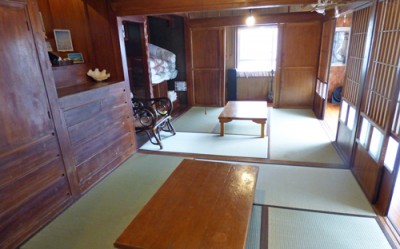
Inside a guest house room.
The owner Hidehiro Noshita said, “We introduce to our guests the town of Koza, which we would like to promote because it benefits us.” Noshita said that he wanted the guests to enjoy the town and learn its history and culture by walking through it. His motto is to enjoy Koza life.
Most of the guests find out about the house over the internet.
This year marks the 11th anniversary since the house was opened. Noshita said, “Although we provide the website only in Japanese, non-Japanese guests manage to make reservations by using translation.” Regarding popularity with domestic and international tourists, Nagami said, “More and more people want to taste the traditional atmosphere of Okinawa.”
The guest can enjoy a barbecue in the garden and drink alcoholic beverages at the bar counter.
Noshita said, “I would like to provide an enjoyable place where guests and local people interact with one another.”
For further details, call guest house Goya at 050(1205)2758.
(English translation by T&CT)
Go to Japanese
November 24, 2014 Ryukyu Shimpo
The government decided to postpone offshore construction work , in Henoko, Nago, where it plans to relocate U.S Marine Corps Air Station Futenma, until December 14, when the House of Representatives election campaign ends. On-shore work, such as preparing a temporary pier will continue, because it is out of view of the protesters, unlike the work at sea.
The Henoko relocation will again become an issue, following the Okinawa gubernatorial race – this time in the House of Representatives national election. Ifthe government goes ahead with the work at sea, there will likely be adverse reactions from residents. Some experts see that the government halted the work, because this would go against the interests of the ruling party’s candidates who favor the Futenma relocation plan to Henoko in the election campaign.
Government officials say there is view that the government should wait and see how Onaga responds the relocation plan, before making a decision on resuming construction work. But there is also a plan by the government to resume the work in January. The officials say the government will be able to obtain the new governor’s approval of an application to change construction methods by putting pressure on him through the Okinawa promotion budget. Work to compile the fiscal 2015 budget, held each year in December, will likely be delayed until January due to the House of Representatives election.
The Okinawa Defense Bureau says it has no plan to delay construction work and will begin as soon as it is ready. The defense bureau was expected to set up a temporary pier from this week. However, it will delay this work. Seabed drilling surveys at nine locations will be carried out no earlier than the middle of December, after the election.
(English translation by T&CT)
Go to Japanese

November 12, 2014 Ryukyu Shimpo
On the morning of November 12, over 50 citizens gathered in front of Gate One at Camp Schwab in Henoko, Nago, to protest against the construction of an alternative base for U.S Marine Corps Futenma Air Station.
Eight nuns of Jesus Caritas from Tokyo and Miyazaki Prefecture visited the Camp Schwab gate, and a protest tent set up on the beach in Henoko. They learned about the current situation and wider military base issues in Okinawa. They visited Okinawa from November 11 to 13. They said they aim to cooperate with Okinawan people and understand the situation in Henoko, as well as that of Takae in Higashi Village, where helipad constructions have been conducted forcibly.
Yuko Ono, who is a nun, said, “Newspapers in the main islands of Japan hardly ever report about Henoko and Takae. After seeing Okinawa, I would like to tell people what it is actually like .”
Early that day, the Japan Coast Guard’s ships were sighted in the sea. However, they did not set up floats again.
(English translation by T&CT and Lima Tokumori)
Go to Japanese
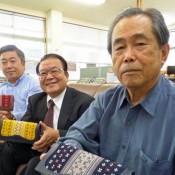
November 20, 2014 Ryukyu Shimpo
Luggage and accessory store Tajimaya has developed original products with Okinawa City’s Chibana Hanaui textile company, which makes state-designated traditional crafts. They released their new products on November 20. Tajimaya, the Chibana Hanaui Business Cooperative, and a leather manufacturer Erina, jointly developed the products. They made five accessory items including a business card holder and a billfold wallet made with top quality Italian leather. The coproducers aim to establish regional branding with Chibana Hanaui and promote these new items.
The co-producers made a series of trial products for one year. Other products
include a coin purse, a long wallet, and a round-shaped wallet. The product comes in three different colors; red, yellow, and navy. These gorgeous, calm colors are
distinctive to the Chibana Hanaui brand.

Tajimaya's new products with Chibana Hanaui textile.
A total of 500 items have been produced for the first round of sales. Prices start from 7,700 yen without tax. On the basis of demand, further production will be considered.
President Gensei Koja of Tajimaya said, “The products have unique styles and designs. It is the first step towards a long held dream to establish an original brand. We would like to expand the range of items to include new products such as shopping bags.”
Chief Executive Junichi Kobashigawa of the Chibana Hanaui Business Cooperative said, “These items are the first ones developed by the companies’ initiatives. Utilizing the characteristics of the textile, the producers have created a very beautiful look.” The products will be released at Tajimaya stores in five locations, including Okinawa City, Naha, and Nishihara. For further details, call Tajimaya main shop at 098 (937) 8117.
(English translation by T&CT and Megumi Chibana)
Go to Japanese
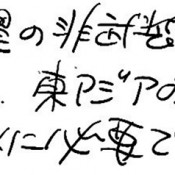
November 14, 2014 Ryukyu Shimpo
Toshinobu Nakazato, former chairman of the Okinawa Prefecture Assembly, has been asking prominent figures in and outside of Okinawa who support the Okinawan people’s movement opposing the deployment of Osprey aircraft to Okinawa and construction of a new U.S military base in Henoko, to send messages to Okinawa.
On November 13, Nakazato released a statement from internationally acclaimed animation director Hayao Miyazaki, who supports the movement.

Internationally acclaimed animation director Hayao Miyazaki
In his directly written message, Miyazaki said, “Demilitarization of Okinawa is essential to create peaceful East Asia.”
On November 8, Miyazaki received an Academy Honorary Award, which is given to international filmmakers who have made significant achievements in the motion picture industry. He is an internationally renowned animation director.
Nakazato and former president of Okinawa University Kunitoshi Sakurai, journalist Akiko Yui, former professor of the University of Ryukyus Tateki Yafuso, and a member of the Japan Scientists Association Shoko Yafuso, have been asking prominent figures to write messages to Okinawa. They received the message from Miyazaki on November 4.
Nakazato and others started sending postcards to about 460 prominent figures in and outside of Okinawa from October 29 and asked them to support the movement opposing the construction of the new base.
In a press conference held at the Okinawa Prefectural Government building, they announced that they had received postcards from 89 supporters.
(English translation by T&CT)
Go to Japanese
November 21, 2014 Ryukyu Shimpo
Offshore construction work for the relocation of U.S. Marine Corps Air Station Futenma to the Henoko district of Nago resumed on November 20. The Okinawa Prefectural Police riot squad and the Japan Coast Guard have beefed up security in the marine area and in front of the Camp Schwab gate, for the planned construction. They forcibly removed citizens protesting. In the struggle between riot police and citizens, an 84-year-old woman who is living in Henoko and taking part in the sit-protest, hit the ground, injuring her head.
Members of the Japan Coast Guard constrained 19 protesters, who were protesting
from canoes. They were temporarily placed on the agency’s inflatable rafts.
In front of the gate, police members interrupted the Ryukyu Shimpo reporter
from reporting on the scene.
Sit-in members prevented trucks loaded with construction materials from entering the gate by sitting down on the road in front of the gate in order to stop the
construction of a makeshift bridge.
The clash between protesters and officers continued while riot squad members were
dragging citizens from the scene.
Hiroji Yamashiro, the director of the Okinawa Peace Movement Center, said, “We will not allow any of the trucks to enter the gate. If the Japanese government intends to force through the Henoko landfill, we will shut down military base operations by stopping the U.S military vehicles from entering the gate.”
(English translation by T&CT)
Go to Japanese
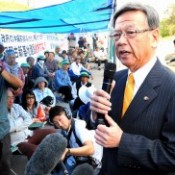
November 19, 2014 Ryukyu Shimpo
Former Naha Mayor Takeshi Onaga, who won the Okinawa gubernatorial election, held on November 16, made an appearance in front of the Camp Schwab gate in the Henoko district of Nago on November 19. It was Onaga’s first visit to Henoko since his win in the gubernatorial election. Speaking to citizens who continue to stage a sit-in protest in front of the gate, Onaga once again promised that as new Okinawa governor he would continue to oppose the plan to relocate U.S. Marine Corps Air Station Futenma to Henoko.
After shaking hands with the protesters and receiving applause from them, Onaga greeted them and thanked them for their contribution to his election win. He said, “Beyond the framework of the conservative-versus-progressive party, I won the election by declaring that I will not allow for the new military base to be built. The U.S military bases are the biggest disincentive for Okinawan economic development. Although Chief Cabinet Secretary Yoshihide Suga said the Japanese government would carry out the plan without making a fuss, I would like to proclaim what a true democratic nation is from Okinawa.”
Earlier that morning, seven trucks loaded with construction materials had entered the gate.
The protesters tried to stop the trucks from entering the gate. Police officers and private security firm workers surrounded them in order to secure entry for the trucks.
The “push and pull” between the police officers and citizens created a chaotic scene.
(English translation by T&CT)
Go to Japanese
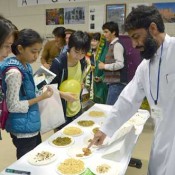
November 12, 2014 Ryukyu Shimpo
On November 8 and 9, Japan International Cooperation Agency Okinawa International Center (JICA Okinawa) held an International Exchange Festival 2014 in Urasoe. JICA interns from 65 different countries took part in the event. Forty-four International exchange and cooperation associations set up booths and an array of multinational food stands. Participants heard many different languages around the room and soaked up the international atmosphere.
A 13-year-old girl Nanami Uezu enjoyed Afghanistan’s almond and pistachio. She said, “They had a different taste from what I had eaten in Japan. They were delicious.”
Hikari Kadena, a 13-year-old boy, said, “I am interested in foreign counties. JICA interns signed words in their languages on papers for me.”
Two brothers from Nago City, Namitaro Nakahara, a 7-year-old, and Sasuke, a 4-year-old, made a Braziliantoy Baieben with PET bottles. They said it was easy to make, and that they would like to play with the toy.
(English translation by T&CT, Hitomi Shinzato)
Go to Japanese












 Webcam(Kokusai Street)
Webcam(Kokusai Street)


